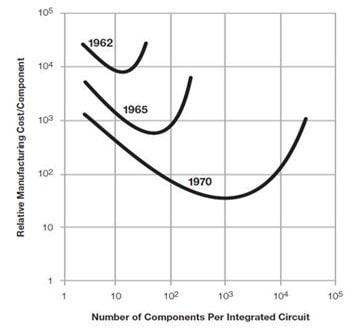In the dynamic field of semiconductor technology, the ongoing discourse surrounding Moore's Law has experienced a notable evolution, prominently featuring Zvi Or-Bach's (MonolithIC 3D’ CEO) 2014 assertion. His statement that transistor cost scaling reached a pivotal juncture at 28 nm and remained static across four subsequent generations has attracted significant attention. The statement was recently validated by Milind Shah from Google in the Short Course (SC1.6) at IEDM 2023. The unequivocal statement, "Transistor cost scaling (0.7X) stalled at 28 nm and remains flat gen over gen'-4, confirming what was initially foreseen in earlier public viewpoints and blogs in 2014 predicting the conclusion of Moore's Law.
Moore's Law, as originally stated is "The complexity for minimum component costs has increased at a rate of roughly a factor of two per year (see graph on next page). Certainly over the short term this rate can be expected to continue”
That was while Intel kept declaring that Moore’s law will prevail for many years to come. Intel published it road map to keep cost per transistor reduction for the foreseeable future as indicated by their following slide.
Zvi Or Bach's 2016 Technical Assertion
Building upon his 2014 insights, Zvi Or Bach delved deeper in 2016, presenting a technical analysis that underlined the stagnation of transistor cost scaling at 28 nm. His meticulous examination considered factors such as escalating lithography cost, and transistor complexity (HKMG, FinFET), resulting in escalating wafer costs, ultimately asserting that this node marked the conclusion of Moore's Law in terms of cost scaling.
The latest technical discussions at IEDM 2023, facilitated by Google SC1.6's Short Course, have substantiated Zvi Or Bach's assertion from 2014. The technical validation affirming "Transistor cost scaling (0.7X) stalled at 28 nm and remains flat gen over gen " stands as a pivotal. This empirical confirmation not only solidifies the ongoing debate with tangible data but also fortifies the technical credibility of Zvi's initial forecast.
The impact of Zvi Or Bach's 2014 publications reverberated through the industry, as evidenced by a cascade of follow-up publications citing his work. Design and Reuse, PhoneArena, SmartBrief, EE Times Asia, and others recognized the significance of the technical insights, amplifying the discussion and contributing to the evolving narrative surrounding the conclusion of Moore's Law.












 RSS Feed
RSS Feed